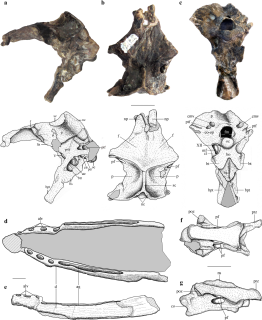 W
WAllkaruen is a genus of "rhamphorhynchoid" pterosaur from the Early-to-Middle Jurassic Cañadon Asfalto Formation in Argentina. It contains a single species, A. koi.
 W
WAmygdalodon was a genus of basal sauropod from the Middle Jurassic of Argentina. The type species is Amygdalodon patagonicus. Fossils of Amygdalodon have been found in the Toarcian Cerro Carnerero Formation of the Jurassic. Very little is known about it, but it is one of the few Jurassic dinosaurs from South America found thus far.
 W
WAndrianavoay is an extinct genus of teleosauroid from the Bathonian of Madagascar.
 W
WAsfaltovenator is a genus of basal tetanuran, possibly allosauroid dinosaur from the Middle Jurassic Cañadón Asfalto Formation from Chubut Province, Argentina. The type and only species is Asfaltovenator vialidadi.
 W
WBagualia, is an extinct genus of eusauropod sauropod dinosaur, from the Early Jurassic of Argentina. The type species, Bagualia alba was formally described in 2020.
 W
WCampylognathoides is a genus of pterosaur discovered in the Württemberg Lias deposits of Germany; this first specimen however, consisted only of wing fragments. Further better preserved specimens were found in the Holzmaden shale; based on these specimens, Felix Plieninger erected a new genus.
 W
WCampylognathoides is a genus of pterosaur discovered in the Württemberg Lias deposits of Germany; this first specimen however, consisted only of wing fragments. Further better preserved specimens were found in the Holzmaden shale; based on these specimens, Felix Plieninger erected a new genus.
 W
WCleviceras is an extinct genus of cephalopod belonging to the family Hildoceratidae. These cephalopods existed in the Jurassic period, during Toarcian and possibly even uppermost Pliensbachian age. Sometimes, it is considered to be a synonym of Eleganticeras.
 W
WThe subfamily Dactylioceratinae comprises early Jurassic ammonite genera that lived during Upper Pliensbachian to Upper Toarcian stage. These dactylioceratids existed from Margaritatus ammonite Zone, when they have evolved from Reynesocoeloceratinae and died out in Variabilis Zone without leaving any descendants.
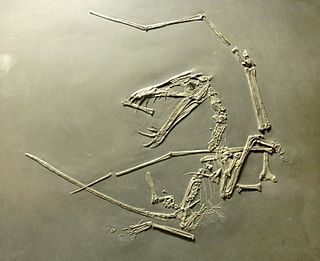 W
WDorygnathus was a genus of pterosaur that lived in Europe during the Early Jurassic period, 180 million years ago when shallow seas flooded much of the continent. It had a short 1.5 meters wingspan, and a relatively small triangular sternum, which is where its flight muscles attached. Its skull was long and its eye sockets were the largest opening therein. Large curved fangs that "intermeshed" when the jaws closed featured prominently at the front of the snout while smaller, straighter teeth lined the back. Having variable teeth, a condition called heterodonty, is rare in modern reptiles but more common in primitive pterosaurs. The heterodont dentition in Dorygnathus is consistent with a piscivorous (fish-eating) diet. The fifth digit on the hindlimbs of Dorygnathus was unusually long and oriented to the side. Its function is not certain, but the toe may have supported a membrane like those supported by its wing-fingers and pteroids. Dorygnathus was according to David Unwin related to the Late Jurassic pterosaur, Rhamphorhynchus and was a contemporary of Campylognathoides in Holzmaden and Ohmden.
 W
WEmausaurus is a genus of thyreophoran or armored dinosaur from the Early Jurassic (Toarcian). Its fossils have been found in Mecklenburg-Vorpommern, northern Germany. Emausaurus is the only known Toarcian thyreorphoran and it is also the only dinosaur from the Ciechocinek Formation with a formal name.
 W
WEurhinosaurus is an extinct genus of ichthyosaur from the Early Jurassic (Toarcian), ranging between 183 and 175 million years. Fossils of the aquatic reptile have been found in Western Europe. They used to live in the deep, open sea area. Eurhinosaurus was a large genus of ichthyosaurs. An adult individual could reach over 6 metres (20 ft).
 W
WHammatoceras is a genus of ammonites belonging to the family Hammatoceratidae which lived during the Late Toarcian stage of the Early/Lower Jurassic between about 184 and 175 million year ago.
 W
WHarpoceras is an extinct genus of cephalopod belonging to the family Hildoceratidae. These cephalopods existed in the Jurassic period, during Toarcian age from Falciferum zone to Commune subzone of Bifrons zone. They were fast-moving nektonic carnivores.
 W
WLobolytoceras is an extinct genus of ammonite in which only the inner whorls have large swollen ribs, later whorls have wrinkled growth lines which coarsen somewhat, near the aperture. The genus is known from the Lower Jurassic Toarcian of Europe. The type species L. siemensi (Denck) came from the Upper Toarcian of Germany.
 W
WMeyerasaurus is an extinct genus of rhomaleosaurid known from Holzmaden, Baden-Württemberg of southwestern Germany.
 W
WMicrocleidus is an extinct genus of sauropterygian reptile belonging to the Plesiosauroidea. It was about the size of a medium-sized dolphin, reaching a length of 3 metres (9.8 ft). The species has 40 neck vertebrae and a short tail of 28 vertebrae. Fossils of the genus have been found in France, the Posidonia Shale in Germany and the Alum Shale Formation of England.
 W
WMystriosaurus is an extinct genus of teleosaurid crocodyliform from the Early Jurassic (Toarcian). Fossil specimens have been found in the Whitby Mudstone of England and Posidonia Shale of Germany. The only known species, M. laurillardi, exceeded 4 metres (13 ft) in length.
 W
WOhmdenia is an extinct genus of prehistoric bony fish that lived from the Toarcian stage of the Early Jurassic epoch. Ohmdenia was first described in 1953 by B. Hauff, based on a fossil found in the well-known Posidonia Shale in Holzmaden, Germany. For a long time this animal has been considered a close relative of Birgeria, a great predator typical of the Triassic period with an uncertain systematic position. Further studies have shown similarities with the pachicormiforms, a group of neopolitics considered close to the origin of teleosts and also including giant forms and planctives. Some studies have erroneously indicated Ohmdenia as a synonym of Saurostomus, other studies have instead placed Ohmdenia as an important evolutionary passage between the basal pachicormiforms and the more derived planktivore pachicormiformes.
 W
WThe Ciechocinek Formation is a Jurassic geologic formation that extends across the Baltic coast, from Grimmen, Germany, to Nida, Lithuania, with its major sequence in Poland and a few boreholes in Kaliningrad.
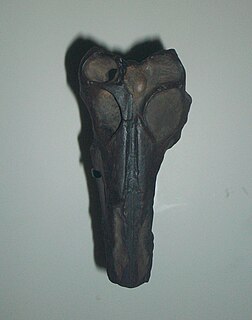 W
WParapsicephalus is a genus of long-tailed rhamphorhynchid pterosaurs from the Lower Jurassic Whitby, Yorkshire, England. It contains a single species, P. purdoni, named initially as a species of the related rhamphorhynchid Scaphognathus in 1888 but moved to its own genus in 1919 on account of a unique combination of characteristics. In particular, the top surface of the skull of Parapsicephalus is convex, which is otherwise only seen in dimorphodontians. This has been the basis of its referral to the Dimorphodontia by some researchers, but it is generally agreed upon that Parapsicephalus probably represents a rhamphorhynchid. Within the Rhamphorhynchidae, Parapsicephalus has been synonymized with the roughly contemporary Dorygnathus; this, however, is not likely given the many differences between the two taxa, including the aforementioned convex top surface of the skull. Parapsicephalus has been tentatively referred to the Rhamphorhynchinae subgrouping of rhamphorhynchids, but it may represent a basal member of the group instead.
 W
WSteneosaurus is a dubious genus of teleosaurid crocodyliform from the Middle or Late Jurassic of France. The genus has been used as a wastebasket taxon for thalattosuchian fossils for over two centuries, and almost all known historical species of teleosauroid have been included within it at one point. The genus has remained a wastebasket, with numerous species still included under the label ‘Steneosaurus’, many of which are unrelated to each other.
 W
WStenopterygius is an extinct genus of thunnosaur ichthyosaur known from Europe. This genus of ichthyosaur grew to a maximum length of 4 meters.
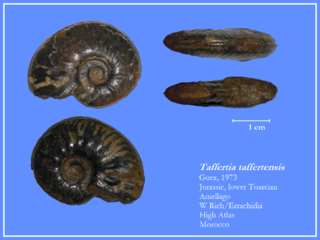 W
WTaffertia is an extinct genus of cephalopod belonging to the family Hildoceratidae. These cephalopods existed in the Jurassic period, during Toarcian age in the Falciferum zone and possibly only in Exaratum subzone. Its fossils were found in Canada, Morocco, Algeria and Italy
 W
WTazoudasaurus is a genus of vulcanodontid sauropod dinosaurs hailing from the Early Jurassic, located in the High Atlas Mountains of Morocco in North Africa. Along with Ohmdenosaurus is one of the two formally described sauropods from the Toarcian of the northern hemisphere.
 W
WTiltoniceras is an extinct genus of cephalopod belonging to the family Hildoceratidae. These cephalopods existed in the Jurassic period, from upper Pliensbachian age, Spinatum zone until lower Toarcian, Tenuicostatum zone in what is now Europe, North America and Asian part of Russia.
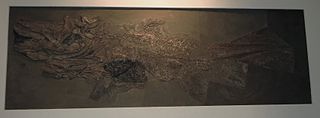 W
WTrachymetopon is an extinct genus of prehistoric coelacanth from the Early Jurassic Posidonia Shale of Germany and the Middle Jurassic of France. Only one species has been named, Trachymetopon liassicum, described by Henning in 1951 from an almost complete specimen found in the Lower Toarcian of Ohmden in Baden-Württemberg. Another specimen is known from the same site, and two older specimens come from the Sinemurian of Holzmaden. The holotype of this species is 1.6 metres in length. A giant specimen of an undetermined species of Trachymetopon is known from the Middle Jurassic of Normandy. This specimen, composed of a 53 cm long palatoquadrate, belongs to an individual 4 metres (13 ft) in length. A study published in 2015 revealed that this coelacanth belongs to the Mawsoniidae. Trachymetopon is one of the few known mawsoniids to have been exclusively marine, while most of the other members of the group have lived in fresh and brackish waters.